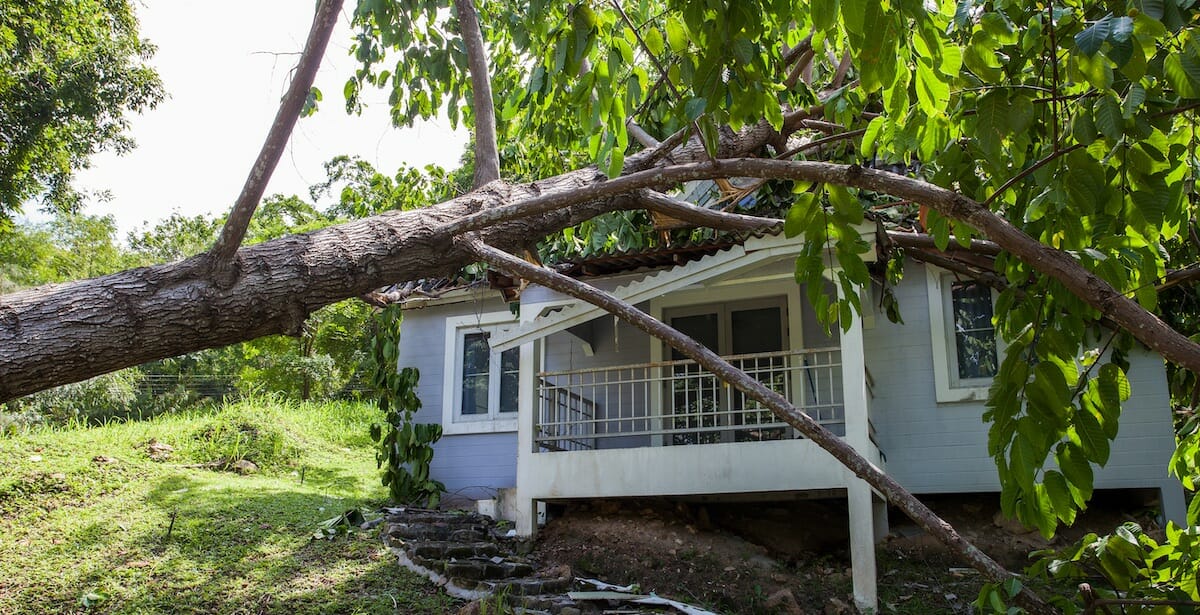Does Home Insurance Cover Tree Trimming?

When you invest in a homeowner’s insurance policy, you do it with the intention that you can get reimbursed should anything happen to your home. Out of all the various dangers your home can face, trees pose a very real threat. This happens usually during storms or the hurricane season, when trees are uprooted, and can even fall on homes.
So, if a tree does fall on your property, will your homeowner’s insurance policy provide payment for the damages? The answer depends on two factors:
- Your homeowner’s policy
- The nature of the damage in question.
Homeowner’s Insurance Policies and Trees
A homeowner’s insurance policy typically provides your home with protection against various risk factors. These include, but aren’t limited to, trees falling on your home, as a result of lightning, a storm, or more. But there are several instances where a tree falling on your property probably won’t result in an insurance payout.
To understand exactly when a homeowner’s insurance policy will pay out, you will need to estimate the nature of the damage first. In addition to this, you’ll also need to check and see what risk factors are covered by your existing homeowner’s insurance policy. If, say, damage to your yard by a tree falling due to a snowstorm is not covered, then you won’t receive a payout.
When Does Insurance Provide Payout for Tree Trimming?
Tree trimming, or the removal of trees post a storm, fire, lightning, or other risk factor covered in your policy, happens in certain specific cases. The basic prerequisite to get your company to pay for the removal of trees from your property, is that your property actually needs to be damaged first.
Please note that while your yard is technically your property as well, for the purposes of insurance, only your home and not the yard is considered.
Here is what happens when you apply for an insurance payout for tree removal in the following circumstances:
1. When a Tree Falls on Your Home
This is the most common scenario where you can expect to receive an insurance payout. However, a tree falling on your home must be covered by your insurance provider as well. You will also find that there are specific risk factors that are covered, and others that are not covered.
So if a tree falls on your home due to a fire, lightning or a storm, then yes, you can receive an insurance payout. But say the same tree falls on your house due to a risk factor that is not covered by your policy. This could be rot, snow, hail, etc., then you won’t receive your payout.
2. When a Tree Falls on Your Yard
Should a tree fall on your yard instead.of your home, then you shouldn’t expect an insurance payout. While your yard is still technically your property, a homeowner’s insurance doesn’t cover tree trimming or falling on the yard.
In the event a tree falls on your yard, due to lightning however, this may be paid for by your insurance carrier. This is as certain risk factors, like lightning and falling airplanes or airplane parts, are covered by many standard homeowner’s insurance policies.
3. Tree Falls on Your Property, But There is No Damage
Now let’s say that a tree fell on your property, but it didn’t do any damage. In this case, can you expect your insurance carrier to pay for removing the tree from your property? The answer to this question usually, is that it depends entirely on what caused the tree to fall, and what damage it did to your property.
Should the tree have fallen due to a covered risk factor, then yes, you can get a payout from your insurance carrier to remove the tree. Now, in the event a covered risk factor isn’t involved, and the tree fell from rot or another unnamed risk factor, then the insurance carrier will not pay out.
4. Falling Rotten and Disintegrating Trees
If your home and property was damaged by a tree that had fallen over due to rot, then the cost of damages isn’t usually covered. This especially applies when a rotting tree falls down on your yard. In this case, you will need to pay to get the tree removed yourself.
5. Neighbor’s Tree Falls on Your Property
What can you do if your neighbor’s tree happens to fall on and damage, your property. Should a neighbor’s tree fall on your home and cause property damage, then you can receive insurance payment. But your carrier can expect your neighbor’s insurance company to provide this payment.
Similarly, if a tree from your property falls on your neighbor’s home, then you can expect your insurance carrier to pay your neighbor’s associated tree trimming and removal costs.
6. Earthquakes and Natural Disasters
Your homeowner’s insurance policy can protect your home against various common risks, such as fire and vandalism. However, not all risk factors are covered. Earthquakes, as an example, are a risk factor that’s commonly not covered by a regular homeowner’s policy. So if a tree falls over on your property due to an earthquake, then you won’t be able to receive insurance costs to remove that tree.
In the same way you would have to pay to remove a rotting tree that’s fallen on your property, you’ll also have to pay to remove trees felled by earthquakes.
7. Snow, Hail, Ice and Snowstorms
Snow and hail can also cause trees to topple over. It is important to note however, that insurance coverage against snow, hail or snowstorms that cause trees to fall, isn’t always a given. Consider asking your insurance carrier to verify whether your homeowner’s policy covers snow and hail or not. If it doesn’t, you can think about purchasing additional coverage.
8. Additional Coverages
While a standard homeowner’s policy can protect your home against the most common risk factors threatening your home, you can also get additional coverages. These ensure that should a tree fall on your home or property due to a covered risk factor, then the insurance company will help you pay for its removal.
Conclusion
A tree can fall on your home due to any reason, from fire to vandalism. Many of the common risk factors your home faces is already covered by a standard homeowner’s policy. This includes a tree falling on your home due to a covered risk factor.
If the tree however, falls on your yard, or falls due to a risk factor that isn’t covered, your insurance won’t pay out the amount. In these cases, you will need to pay to have the tree removed yourself. Check out these tips for hiring a tree removal service, including making sure the business has proper coverage incase anything goes wrong when they are working on your property! Some instances, such as a tree falling due to a lightning strike, vandalism, explosion, and other factors, you can receive an insurance payout. Consider investing in insurance that protects your home from falling trees.
Damage to home and property can be expensive to repair. In most cases, you can receive a payout should your home be damaged in any way. This doesn’t always extend to your yard however, so getting additional coverage for that might be a good idea. If a tree from your property damages a neighbor’s home or vice versa, you can expect to your insurance carrier to pay your neighbor to have the tree removed.
Removing a fallen tree and repairing damaged property can be expensive, which is why a good homeowner’s insurance can be the key to a well protected home.

